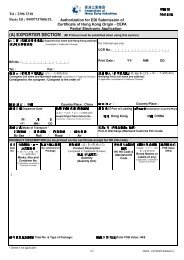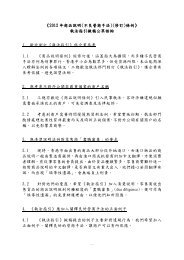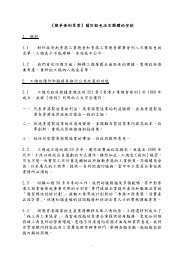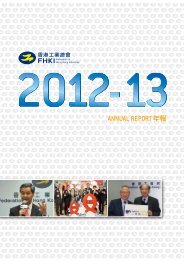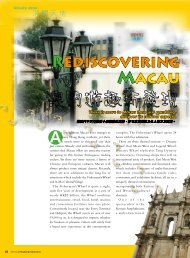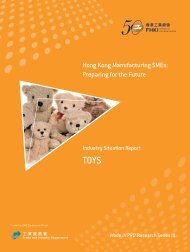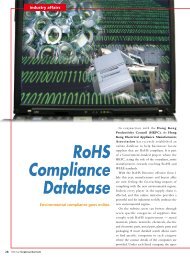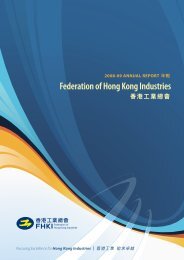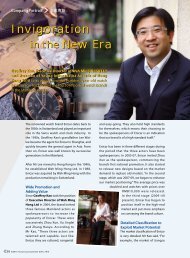Hong Kong Manufacturing SMEs: Preparing for the Future
Hong Kong Manufacturing SMEs: Preparing for the Future
Hong Kong Manufacturing SMEs: Preparing for the Future
- No tags were found...
You also want an ePaper? Increase the reach of your titles
YUMPU automatically turns print PDFs into web optimized ePapers that Google loves.
101manufacturing jobs, which is still not <strong>the</strong> case inlarge portions of China’s interior.• Develop managerial talent from <strong>the</strong> ChineseMainlandMany <strong>Hong</strong> <strong>Kong</strong> manufacturing <strong>SMEs</strong> preferto hire managers from <strong>Hong</strong> <strong>Kong</strong>. However,<strong>the</strong> supply of trained <strong>Hong</strong> <strong>Kong</strong> managerswith manufacturing experience is declining. Oneobvious potential source of managers is <strong>the</strong>Chinese Mainland. Here <strong>the</strong> best approach maybe bringing in relatively young managers anddeveloping <strong>the</strong>m within <strong>the</strong> organisation. Thechallenge is that it may be difficult to retain suchpeople, who may leave to work <strong>for</strong> competitorsor set up competing companies of <strong>the</strong>ir own.This may be unavoidable. The key is likely to behow <strong>the</strong> company tries to instil loyalty and asense of belonging within <strong>the</strong> firm.• Bring in managerial talent from elsewhereIn addition to <strong>Hong</strong> <strong>Kong</strong> and <strong>the</strong> ChineseMainland, <strong>Hong</strong> <strong>Kong</strong> <strong>SMEs</strong> should considermanagers from o<strong>the</strong>r locations, such as Taiwan,Korea, Singapore, Malaysia, and o<strong>the</strong>r places inSou<strong>the</strong>ast Asia. Several of <strong>the</strong>se economies havemore of an ongoing manufacturing tradition than<strong>Hong</strong> <strong>Kong</strong> and managers from <strong>the</strong>se locationsmay be less likely to start up competing firms of<strong>the</strong>ir own in China. This may require SME ownersand managers to travel more and look beyond<strong>the</strong>ir traditional sources of managerial talent.• Share wealth with management talentProviding senior managers with some stake in<strong>the</strong> business, such as rewards linked to companyper<strong>for</strong>mance or even an ownership share, canprovide motivation and may make it easier toretain key personnel. This may be difficult in SMEcorporate cultures where often only a singleindividual has a real stake in <strong>the</strong> success of <strong>the</strong>firm. The trouble is that in such structures anyonewith sufficient talent will soon go elsewhere orstart up on <strong>the</strong>ir own.Business Model StrategiesChanges in business models involve changing<strong>the</strong> activity mix of <strong>the</strong> company in order to focuson <strong>the</strong> activities in which <strong>the</strong> company can buildcompetitive advantages and leave o<strong>the</strong>r activitiesbehind. Examples of such strategies include:• Shift from manufacturing to outsourcingproductionIf <strong>the</strong> <strong>Hong</strong> <strong>Kong</strong> manufacturing <strong>SMEs</strong> believethat o<strong>the</strong>rs, such as firms from <strong>the</strong> ChineseMainland, will have an unassailable costadvantage, or that <strong>the</strong>y will not be able to obtainsuitable margins through manufacturing, <strong>the</strong>ymay shift from manufacturing to outsourcingproduction to o<strong>the</strong>rs. In such cases, <strong>the</strong> <strong>Hong</strong><strong>Kong</strong> SME would use its knowledge of marketsand contacts with customers to sell its outsourcedproduction.• Become a trader or agent <strong>for</strong> o<strong>the</strong>rcompaniesThe extreme case of outsourcing would bemanufacturing <strong>SMEs</strong> trans<strong>for</strong>ming <strong>the</strong>mselvesinto traders or agents <strong>for</strong> o<strong>the</strong>r companies.Again, <strong>the</strong>y would use <strong>the</strong>ir market knowledgeand customer relations to sell <strong>the</strong> traded goods.Presumably <strong>the</strong>y would be sourcing from o<strong>the</strong>r<strong>Hong</strong> <strong>Kong</strong> firms or firms from <strong>the</strong> ChineseMainland in most cases, though in some sectors,finding sources in South Asia or Sou<strong>the</strong>ast Asiawould also be desirable.• Become a subcontractorThe opposite approach would be to becomea subcontractor <strong>for</strong> a larger company, letting<strong>the</strong> larger company deal with powerfulbuyers, export-related regulations, and o<strong>the</strong>radministrative matters. This approach has beenused by a number of companies that no longercan or wish to deal with <strong>the</strong> administrativeburden of being an exporter <strong>the</strong>mselves soinstead supply o<strong>the</strong>r companies that have <strong>the</strong>administrative capacity, financial strength, andaccess to customers to continue to export.



